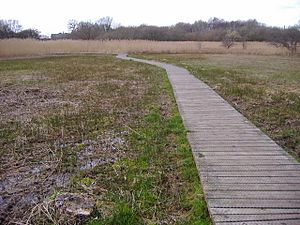Southrepps Common facts for kids
| Site of Special Scientific Interest | |
 |
|
| Area of Search | Norfolk |
|---|---|
| Interest | Biological |
| Area | 5.6 hectares (14 acres) |
| Notification | 1990 |
| Location map | Magic Map |
Southrepps Common is a special natural area in Norfolk, England. It covers about 5.6 hectares (14 acres) and is known for its amazing wildlife. This area is so important that it has several special protections. It is a Site of Special Scientific Interest (SSSI) and also a larger Local Nature Reserve (LNR) covering 12.9 hectares (32 acres).
The local community helps look after Southrepps Common. It is owned by the Southrepps Parish Council and managed by a group called the Southrepps Common Group. This special place is also part of a bigger protected area called the Norfolk Valley Fens Special Area of Conservation.
What Makes Southrepps Common Special?
Southrepps Common is a unique habitat. It has damp grasslands and areas called "fen." A fen is a type of wetland that gets its water from groundwater, which makes it rich in minerals. This creates a perfect home for many different plants and animals. The common is located in the valley of the River Ant.
Rare Insects and Their Life Cycle
This wetland is home to several rare insects, especially certain types of "true flies." These flies are very important because they show that the wetland is healthy and undisturbed. Two examples of these rare flies are Pteromicra glabricula and Colobaea distincta.
These flies have an interesting life cycle. Their young, called larvae, live as parasites. This means they live on or inside other creatures and get their food from them. In this case, the larvae of these flies are parasitic on snails. They depend on snails to grow and develop. This makes the snails a very important part of the ecosystem at Southrepps Common.
Visiting Southrepps Common
Southrepps Common is a wonderful place to explore nature. It is open to the public, so you can visit and see its unique habitats and perhaps even spot some of its special wildlife. It's a great example of how local communities can work together to protect important natural spaces.

